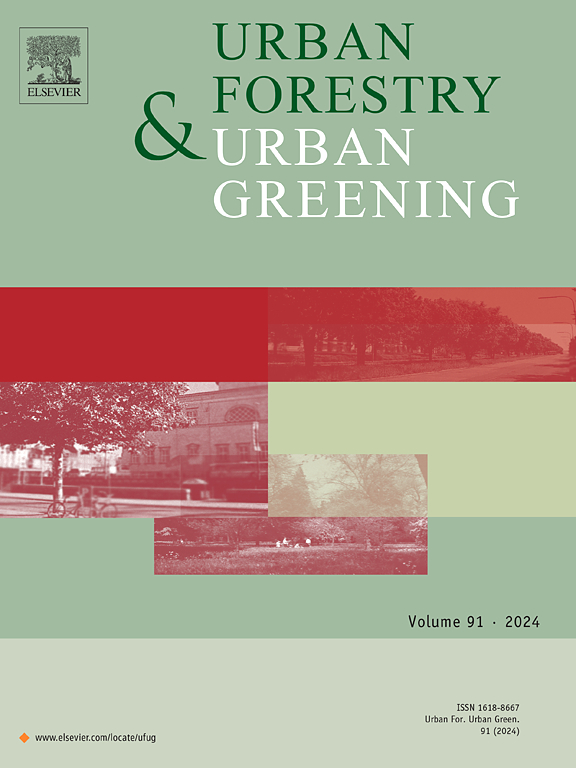草坪管理强度对地下生态和草坪草美学的影响是截然不同的
IF 6
2区 环境科学与生态学
Q1 ENVIRONMENTAL STUDIES
引用次数: 0
摘要
家庭草坪是美国最常见的城市地表之一,提供了许多文化和生态效益。其中许多益处来自草坪草土壤及其地下生态系统。随着房主对管理草坪以实现不同生态系统服务的兴趣的增长,了解不同的管理实践如何影响这些目标以及管理地下生态的努力如何改变草坪的质量和美学是很重要的。在本研究中,我们利用实验草坪系统来对比管理强度对土壤动物群落、微生物生物量和分解的影响。此外,我们同时研究了这些地下生物和过程的优先级如何无意中改变草坪质量。结果表明,管理强度的降低导致土壤动物群落的丰度、丰富度和多样性的增加,这些变化在某些类群中最为明显,如掠食性螨(如中刺螨)。尽管土壤动物显著增加,但我们没有观察到土壤微生物生物量的下游变化,碳或氮或分解,土壤生态系统功能的所有方面都是由土壤动物介导的。此外,草坪美学评估显示,在低强度管理的情况下,草坪质量大幅下降。总的来说,这些结果突出了草坪草系统的微妙生态,如果我们要促进草坪草评估转向重视生态完整性,就需要缓和社会对草坪草美学的期望。本文章由计算机程序翻译,如有差异,请以英文原文为准。
Lawn management intensity leads to contrasting effects on belowground ecology and turfgrass aesthetic
Home lawns are one of the most common urban land surfaces in the United States and provision many cultural and ecological benefits. Many of these benefits arise from turfgrass soils and their belowground ecosystems. As homeowner interest in managing lawns for diverse ecosystem services grows, it is important to understand how varying management practices affect these goals and how efforts to manage belowground ecology may alter lawn quality and aesthetic. In this study we utilized an experimental lawn system to contrast the effects of management intensity on soil fauna communities, microbial biomass, and decomposition. Further, we simultaneously investigate how the prioritization of these belowground organisms and processes may inadvertently alter lawn quality. Our results show that decreasing management intensity leads to increases in the abundance, richness, and diversity of soil fauna communities, with these changes being most apparent in certain taxa like predatory mites (e.g. Mesostigmata). Despite significant increases in soil fauna, we did not observe downstream changes to soil microbial biomass carbon or nitrogen or decomposition, all aspects of soil ecosystem functioning which are mediated by soil fauna. Further, turf aesthetic assessments revealed substantial decreases in lawn quality in the presence of low-intensity management. Collectively, these results highlight the nuanced ecology of turfgrass systems, and the need to temper societal expectations for turfgrass aesthetics if we are to promote a shift towards valuing ecological integrity in turfgrass appraisals.
求助全文
通过发布文献求助,成功后即可免费获取论文全文。
去求助
来源期刊

Urban Forestry & Urban Greening
FORESTRY-
CiteScore
11.70
自引率
12.50%
发文量
289
审稿时长
70 days
期刊介绍:
Urban Forestry and Urban Greening is a refereed, international journal aimed at presenting high-quality research with urban and peri-urban woody and non-woody vegetation and its use, planning, design, establishment and management as its main topics. Urban Forestry and Urban Greening concentrates on all tree-dominated (as joint together in the urban forest) as well as other green resources in and around urban areas, such as woodlands, public and private urban parks and gardens, urban nature areas, street tree and square plantations, botanical gardens and cemeteries.
The journal welcomes basic and applied research papers, as well as review papers and short communications. Contributions should focus on one or more of the following aspects:
-Form and functions of urban forests and other vegetation, including aspects of urban ecology.
-Policy-making, planning and design related to urban forests and other vegetation.
-Selection and establishment of tree resources and other vegetation for urban environments.
-Management of urban forests and other vegetation.
Original contributions of a high academic standard are invited from a wide range of disciplines and fields, including forestry, biology, horticulture, arboriculture, landscape ecology, pathology, soil science, hydrology, landscape architecture, landscape planning, urban planning and design, economics, sociology, environmental psychology, public health, and education.
 求助内容:
求助内容: 应助结果提醒方式:
应助结果提醒方式:


